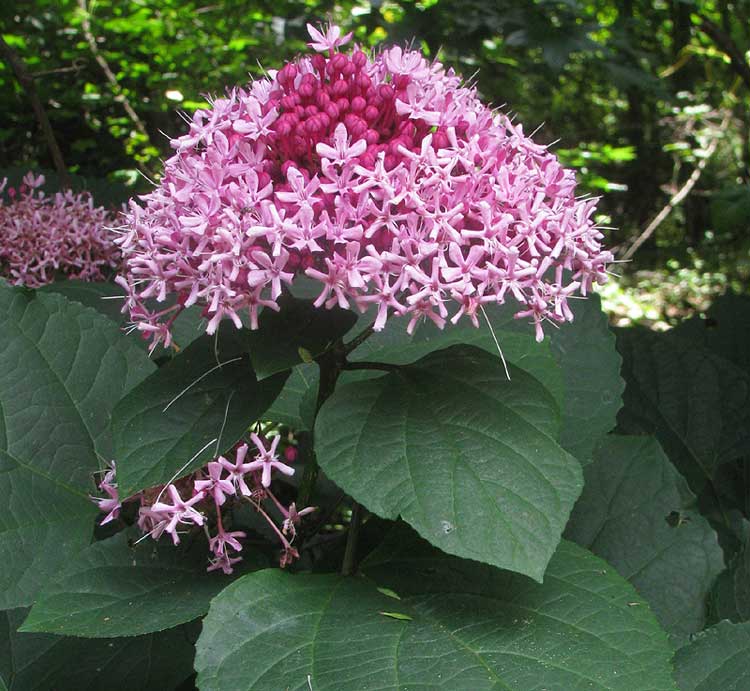Excerpts from Jim Conrad's
Naturalist Newsletter

from the the August 5, 2012 Newsletter issued from the woods of the Loess Hill Region a few miles east of Natchez, Mississippi, USA
ROSE GLORYBOWER
In an isolated part of the county the weedy edge of an upland woods gave way to something new, something definitely not part of the local natural flora, obviously an ornamental plant escaped from cultivation or surviving as a relict where once a house stood, though now there was nothing but woods. You can see the seven-ft-tall (2m) wall of foot-long leaves and cantaloupe-sized flower heads below:

A close-up of a cluster of five-lobed, rosy-pink flowers is at the top of this page.
Close up you can see the flowers' slender, inch-long (2.5cm) corolla tubes with slender, white styles projecting from them, and each with four stamens that curve backwards, away from the style, hindering self-pollination, below:

We've seen something very close to this down in the Yucatan, and you might enjoy comparing the above pictures with what's shown on our page at http://www.backyardnature.net/yucatan/javaglor.htm.
Notice the flower structure of both species is very similar, both even having turned-back stamens, but the plants display different growth forms. The Yucatan plant, the Java Glorybower, was Clerodendrum speciosissimum, so I figured that what we had here was another Clerodendrum, a genus in the Verbena Family famous for producing spectacular shrubs and trees mostly in tropical Asia. Members of the genus Clerodendrum often are known as glorybowers.
Our relict roadside plant is CLERODENDRUM BUNGEI, from China, so widely planted throughout warm parts of the world that it has many English names, including Rose Glorybower, Cashmere Bouquet, Mexicali Rose and Mexican Hydrangea.
The attractiveness of this bush is obvious so I figured that online gardening forums would be filled with adulatory remarks from growers. Gardeners in the US Deep South, especially Florida, do agree that it's an elegant presence in any garden, but nearly everyone also remarks on how aggressively it expands into new territory and how hard it is to get rid of. And some complain of the stinky foliage, which one grower describes as like a giant vitamin pill. I found the odor penetratingly musky in a way typical of many vebenaceous species, but not really unpleasant. Everyone agrees that the odor makes them invulnerable to deer.
Whatever the consensus among gardeners regarding Clerodendrum bungei, discovering it surviving so lustily at an isolated woods edge, swarming with pollinators and adding spectacular splashes of color to an otherwise endless murmuring of shadowy shades of green, I was glad to make its acquaintance.